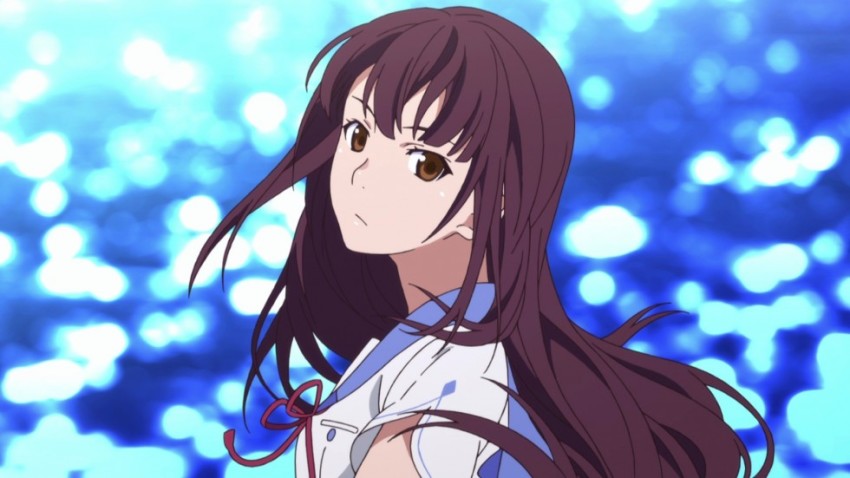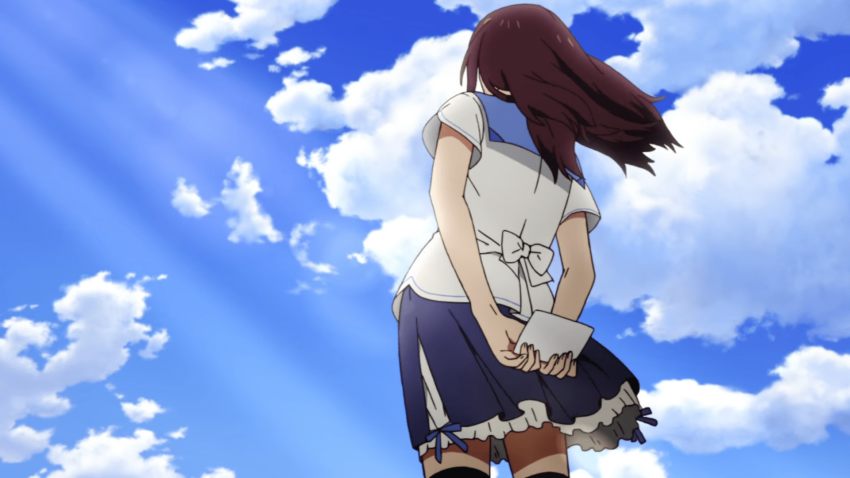Fireworks
November 3, 2018 · 0 comments
By Andrew Osmond.
 In Britain and America, time-travel is often the pretext for a big story, and doubly so in animation. After all, T-Rexes or Terminators aren’t more expensive to animate than present-day Japan. And yet, anime often goes for the small time-travel tale. Think of The Girl Who Leapt Through Time, a story with no cosmic disasters or flying cars, just a girl hopping around a few hours or days. Or take a series like Steins;Gate – it gets “big” eventually, but much of it takes place in one unglamorous room in Akihabara, where oddball characters do silly experiments with microwaved bananas.
In Britain and America, time-travel is often the pretext for a big story, and doubly so in animation. After all, T-Rexes or Terminators aren’t more expensive to animate than present-day Japan. And yet, anime often goes for the small time-travel tale. Think of The Girl Who Leapt Through Time, a story with no cosmic disasters or flying cars, just a girl hopping around a few hours or days. Or take a series like Steins;Gate – it gets “big” eventually, but much of it takes place in one unglamorous room in Akihabara, where oddball characters do silly experiments with microwaved bananas.
Fireworks is another “small” film, though its final scenes have playful suggestions of a realm where scale is meaningless; as tiny as a droplet, as vast as a galaxy. For a large part, though, it’s another film about oddballs mucking around. These oddballs are middle-school kids, in a town by the sea called Moshimo (a Japanese name that can be read as “What if?”) At first, we mostly see a band of boys; they race to school on bikes and skateboards, ogle girls shamelessly, and argue about such matters as whether fireworks look flat or round when you see them from the side.
But one of the boys, Norimichi, notices a female classmate he likes, Nazuna, standing by the sea, looking isolated and forlorn. Gradually, Norimichi’s day coalesces around Nazuna. He finds her lying by the school pool and she challenges him and a male friend to a swimming race. Norimichi loses – mostly because Nazuna’s beauty scares as much as attracts him – but he’ll bump into her again. Before the sun sets, he’ll see her at her most alluring, talking temptingly of running away; then he’ll see her hopeless and helpless, being dragged off by a stern parent.
 But then a miracle happens, and Norimichi gets the chance to turn back time, and try again to help Nazuna… and then to try again… and again. Most viewers will have seen this kind of story – Fireworks comes out the same year as at least two American time-loop films, Happy Death Day and Before I Fall. However, Fireworks boasts the ornate presentation of the Shaft studio, famed for such series as Bakemonogatari and Madoka Magica. While Fireworks is more mainstream-looking, it’s full of recurring visual motifs. Sometimes their significance is obvious, such as the huge rotating wind turbines in the backgrounds, recalling the hands of a giant clock. Some motifs pay off in retrospect, such as the myriad water droplets scattering from a sprinkler, a hose and Nazuna’s own hair as she shakes it in the sea.
But then a miracle happens, and Norimichi gets the chance to turn back time, and try again to help Nazuna… and then to try again… and again. Most viewers will have seen this kind of story – Fireworks comes out the same year as at least two American time-loop films, Happy Death Day and Before I Fall. However, Fireworks boasts the ornate presentation of the Shaft studio, famed for such series as Bakemonogatari and Madoka Magica. While Fireworks is more mainstream-looking, it’s full of recurring visual motifs. Sometimes their significance is obvious, such as the huge rotating wind turbines in the backgrounds, recalling the hands of a giant clock. Some motifs pay off in retrospect, such as the myriad water droplets scattering from a sprinkler, a hose and Nazuna’s own hair as she shakes it in the sea.
The titular fireworks appear in multiple shapes and geometries through the film. They stand for love and passion, of course, but also for magic as perceived by children, and those who’ve not left childhood behind. In similar vein, the film makes play with curved and corrugated glass, suggesting mystic windows into reshaped worlds.
A huge proportion of anime centres around teenagers, but Fireworks catches the feeling that adolescence is when one’s future is most open-ended, when your future could diverge the most depending on the decisions you make, the character you build – do you dither, or do you act? The film also suggests subjective kinds of “time-travel” for teenagers looking into past and future. The girl character Nazuna may be running away from her parents, but she’s inspired by the actions of her mother, which led to Nazuna’s own birth. Nazuma also projects herself into the future, striving to look and act older than she is – she scolds Norimichi for talking about “running away”, which doesn’t sound nearly as grown-up as eloping. In some ways, it’s a shame Nazuna isn’t the main viewpoint character, and forced to evaluate her own decisions, which are far more complex and contradictory than Norimichi’s.
In one fantasy scene, the supposedly grown-up girl sings an “old” idol song – again, a piece of the past driving her hopes for the future – while she has visions of being a fairy-tale princess. The interlude parallels a memorable dream (or dream-in-dream) scene in the 1980s fantasia Labyrinth, where Jennifer Connelly’s fantasy of adulthood is to dance with sex sorcerer David Bowie in a soap-bubble ballroom. In Fireworks, Nazuna only has Norimichi to practice on; the boy is comically overwhelmed, having probably never had an adult thought in his life. But then sexuality gives way to more innocent dreams of escaping, of just travelling farther and farther out of the world. One of the last fantasy images recalls one in Hayao Miyazaki’s Spirited Away, with CG provocatively replacing the traditional animation; another old dream updated for a new generation.
 Fireworks would make an especially good double-bill with the animated Case of Hana and Alice. The two films are connected, both linked to live-action films by the director Shunji Iwai. Fireworks is a remake of an early 1993 Iwai TV movie; he didn’t direct the anime version, but it has a broad structural similarity to Case of Hana and Alice which Iwai did direct. In both films, the early scenes depict one character – in Fireworks it’s Norimichi – amid a large number of peers, any of whom might be major players. There are trivial scenes of everyday life, full of cheerfully “purposeless” details (like Norimichi’s parents, who are glimpsed at the beginning and never again). Later, both films focus on just two youngsters, running around by themselves and learning as much about themselves as each other. In effect, the films leave it to their characters to decide what’s important.
Fireworks would make an especially good double-bill with the animated Case of Hana and Alice. The two films are connected, both linked to live-action films by the director Shunji Iwai. Fireworks is a remake of an early 1993 Iwai TV movie; he didn’t direct the anime version, but it has a broad structural similarity to Case of Hana and Alice which Iwai did direct. In both films, the early scenes depict one character – in Fireworks it’s Norimichi – amid a large number of peers, any of whom might be major players. There are trivial scenes of everyday life, full of cheerfully “purposeless” details (like Norimichi’s parents, who are glimpsed at the beginning and never again). Later, both films focus on just two youngsters, running around by themselves and learning as much about themselves as each other. In effect, the films leave it to their characters to decide what’s important.
For anime fans, Fireworks is significant as the Shaft studio’s first stand-alone cinema film, not overtly linked to a TV anime. Perhaps Shaft was encouraged by the example of Kyoto Animation, which took a similar step last year with the acclaimed A Silent Voice. Shaft fans, though, have already been busy comparing character designs, as Nazuna’s coquettish expressions are markedly similar to those of the even more cutely intimidating Hitagi in Bakemonogatari; both characters shared designer Akio Watanabe. Meanwhile, Shaft and Kyoto Animation fans should both pay attention to Fireworks’ rich music, by Satoru Kousaki, whose work spans multiple “Monogatari” titles, Haruhi Suzumiya and Lucky Star. The music blends well with the end credits song, which was created by Kenshi Yonezu and performed by him with female rapper DAOKO.
Both Norimichi and Nazuna are voiced by anime “outsiders”, Masaki Suda and Suzu Hirose – though Hirose voiced Kaede in Mamoru Hosoda’s The Boy and the Beast, another girl far more interesting than her narratively restricted role. In Fireworks, the famous anime actors are in the support cast, including Mamoru Miyano (Light in Death Note) as Norimichi’s love-rival Yusuke, who has a worryingly puerile obsession with his bowel movements. Their female teacher Miura-sensei is voiced by another industry titan, Kana Hanazawa, who’s in pretty much everything; one of her latest roles is as middle sister Hinata in March Comes in Like a Lion. Her Fireworks character is a buxom teacher who suffers constant sexual harassment from students, played for laughs. These scenes have rightly offended viewers; however, it’s possible that Hanazawa’s casting was meant as the key joke, spoofing her far more dignified teacher roles in The Garden of Words and Your Name.
Andrew Osmond is the author of 100 Animated Feature Films. Fireworks is released in the UK by Anime Limited.
Leave a Reply